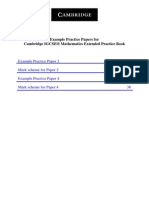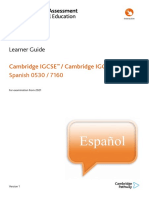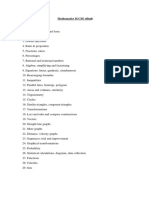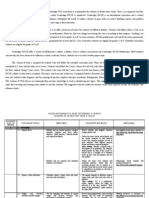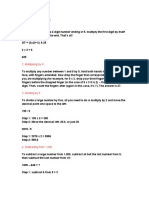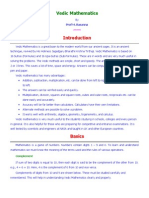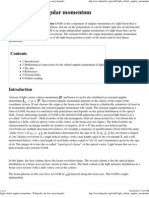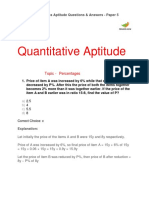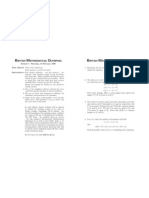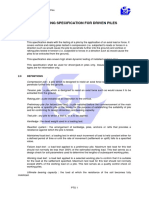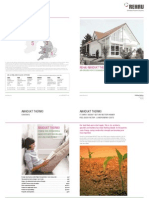IGCSE MATHS Booklet 2015 1 Numbers
Uploaded by
Gastón MaireIGCSE MATHS Booklet 2015 1 Numbers
Uploaded by
Gastón MaireGUIDES AND
TIPS
FOR
IGCSE
MATHS
IGCSE GUIDE MATHS - 5 Year
IGCSE GUIDE MATHS - 5 Year
NUMBER
IGCSE GUIDE MATHS - 5 Year
VOCABULARY
First, some important words, know what they mean (get someone to test you):
Integer a whole number.
2, 0 and -17 are integers, but , 0.247, 3 and are not
Factor a whole number that 'goes into' another number exactly. the factors of
6 are 1, 2, 3 and 6
Prime Number a whole number with exactly two factors, namely 1 and itself. 2,
3, 5, 7 and 11 are prime numbers, but 1, 4, 6, 8 and 9 are not
Highest Common Factor (HCF) the biggest number that goes into two (or
more) others, the HCF of 20 and 28 is 4
Lowest Common Multiple (LCM) the smallest number that two (or more)
others go into, the LCM of 20 and 28 is 140
Product the result of multiplying several numbers together. the product of 2
and 3 is 6
Square Number a whole number squared (or multiplied by itself).
1, 4, 9 and 16 are square numbers because they are given by 11, 22, 33,
44
Surd a 'nasty' root, one whose decimal goes on forever without repeating.
2 (= 1.41421356...) and 3 (= 1.7320508...) are surds, but 4 (= 2 exactly) is
Recurring Decimal one which contains a digit (or block of digits) repeating
forever.
1
/3 = 0.33333...
and 1/7(sig
= 0.142857142857...
recurring
decimals
Significant
Figures
figs or sf) start are
counting
from the
first non-zero digit.
The number 0.000016573 has 5 significant figures
Decimal Places (dp) start counting from the decimal point. The number
0.000016573 has 9 decimal places
Indices (plural of index) little raised numbers representing powers (squared,
cubed, etc.). in the example 3, 3 is the base and 2 is the index
Standard Form a number written as A 10N, where 1 A < 10 and N is a
whole number.
-3
32000
= 3.2'one
104 over'
and a0.00198
=11.98
10by
when
converted
to standard
Reciprocal
number,
divided
a
number;
you 'flip'
a fraction to
7
11
do this. the reciprocal of 4 is ; the reciprocal of /11 is /7
Numerator the top number in a fraction. the numerator of is 3
Denominator the bottom number in a fraction. the denominator of is 4
Common denominator the LCM of several denominators, used if we
add/subtract fractions. to add 2/3 and 1/5, we use a common denominator of 15
Mixed Number or Mixed Fraction a number consisting of an integer and a
fraction.
Evaluate work out the value of.
to evaluate 3.4 1.4, work it out according to BIDMAS = 3.4 1.96 = 6.664
Estimate work out the rough value of (round numbers in the question to 1 sig
fig, usually). to estimate 3.9 9.1, first round the values and then work out 4
9 = 36
IGCSE GUIDE MATHS - 5 Year
ARITHMETIC
Evaluate means 'work out the value of'.
You can usually type the numbers straight into your calculator, but beware!
Faulty Squares: if you type 2 the calculator gives 4 (it
should
4). Get
round this by typing (2)
Be be
REALLY
careful
with this!
Big Divide:
Use the
1+2
4+5
is not the same as
1+2 4+5
key to enter big fractions, or insert brackets like this: (1 + 2) (4
+ 5)
IGCSE INSIDER INFO: 27% of marks rely on calculator usage. That's a C grade!
BIDMAS stands for Brackets, Indices, Divide Multiply, Add Subtract.
This is the order in which you should carry out calculations.
Do anything in brackets first, followed by indices (powers and roots), then and
together, then + and together.
TIP: Not a lot of people realize this, but Divide & Multiply are on the same level,
and Add & Subtract are on the same level.
This means that if you have 1 2 + 3, you don't do + before to get 1 5 = 4.
You just work from left to right to get 1 2 + 3 = 2.
It's the same with and ; just work from left to right.
Your calculator does BIDMAS automatically, but note 'Faulty Squares' and 'Big
Divide' mentioned above.
Negative Numbers remember these rules!
SKILL: Add or subtract negative numbers.
Go up/down in a lift, but 'minus a minus' goes up. (Imagine making a + sign out of
two adjacent signs.)
TIP: Sending someone naughty out of the class ('subtracting a negative') has a
positive effect on the class.
Q: Work out
2
+
(-3)
4
A: Total so
2
( 3) (
far:
1
4)
SKILL: Multiply or divide negative numbers.
Two minuses make a plus. One minus makes a minus.
Q: Work out (-3) (-4) (-2):
A: First, do the numbers: 3 4 2 = 6.
((
5)
5)
0.
IGCSE GUIDE MATHS - 5 Year
Then decide if it's + or : two of the minuses cancel out, leaving 6.
IGCSE GUIDE MATHS - 5 Year
ROUNDING AND ESTIMATION
Rounding numbers
We are often asked to round our answers in IGCSE exams.
Remember:
A number rounds up if the next digit is 5 or
above.
A number rounds down if the next digit is 4 or below.
IGCSE INSIDER INFO: Really important, this one...
You can't (usually) lose marks for being too accurate!
[The mark scheme will say 'award marks for 3 sig figs or greater']
So: if in doubt, just write down all the digits of your
answer.
WARNING: There are two exceptions to this:
1) When you have just given an accurate answer and
then you are asked to round it. (In this case of course
round it)
SKILL: Round a number to N decimal places.
Start counting digits after the decimal point, then round up/down as
appropriate.
Q: Round 31.5735189 to 3 decimal places.
A: Chop the number of after 3 decimal places: 31.573
5189 Now round up because a 5 comes next.
31.574
Sneaky super-rounding situation: 99.9999 rounded to 2 dps
becomes 100.00. (You may have to pad out the number with zeros to
give it the right number of dps.)
SKILL: Round a number to N significant figures.
Start counting from the first non-zero digit, then round up/down as
appropriate.
Q: Round 0.00084631 to 2 significant figures.
A: Chop the number of after 2 significant figures:
0.00084
631 Now round up because a 6 comes next.0.00085
Ever-so-slightly evil example: 137423 rounded to 3 sf becomes
137000, not 137. (You have to pad out the number with enough zeros
to make it the right size.)
SKILL: Estimate the answer to a calculation.
Round all the numbers in the question to 1 significant figure, then find the
answer.
IGCSE GUIDE MATHS - 5 Year
Q: Estimate (3.187 + 6.893) 0.2096.
A: Round to 1 sig fig first: (3 + 7) 0.2 = 10 0.2 = 2.
The symbol means approximately equal to.
Make sure you don't round 0.2096 down to zero by mistake... It's sig figs, not
dp!
IGCSE GUIDE MATHS - 5 Year
UPPER AND LOWER BOUNDS
Upper and Lower Bounds
This is roughly the reverse of the previous section: what is the question to my
answer?
Q: If a number has been rounded to 1.23 (correct to 2 dps), what could it
have been originally?
A: It can help to sketch out a ruler marked with 1.22, 1.23, 1.24, etc.
1.22
1.23
1.24
Any measurements in the grey region would round to 1.23 rather than to
1.22 or 1.24. This region clearly extends from 1.225 up to 1.235 (not
inclusive).
So the lower bound is 1.225 and the upper bound is 1.235.
Although that upper bound is not inclusive, it's the answer they want you
to give.
SKILL: Find the lower and upper bounds of a rounded number
Sketch the appropriate ruler, then read of 'half way down' and 'half
way up'.
Q: Find the lower and upper bounds of 3.009cm (correct to 4 sig
figs).
A: Sketch the ruler:
3.008
3.009
3.010
Lower bound = 3.0085cm Upper bound = 3.0095cm
Calculations with Upper and Lower Bounds
Q: If a runner covers 200m in 23.3 sec, what is her greatest and least possible
speed?
A: Well, if the distance is accurate to the nearest metre and the time is
accurate to the nearest 0.1 second, we can find the lower and upper bounds
for each of these:
Distance:
lower bound = 199.5m,
upper bound =
200.5m
IGCSE GUIDE MATHS - 5 Year
Time:
lower bound = 23.25
upper bound =
sec,
23.35 sec
Now using the DST triangle, Speed = Distance/Time.
So her greatest possible speed = Max Distance/Min Time = 200.5/23.25 =
8.624 m/s
and her least possible speed = Min Distance/Max Time = 199.5/23.35 =
8.544 m/s
IGCSE GUIDE MATHS - 5 Year
PRIMES AND FACTORS
A factor is a whole number that 'goes into' another number exactly.
For example, the factors of 10 are 1, 2, 5 and 10.
SKILL: List all the factors of a number.
Q: List all the factors of 72.
A: Do this in pairs as follows (each pair multiplies to make 72):
1, 72
2,
3,
4,
6,
8,
36
24
18
12
9
A prime number has exactly two factors, namely 1 and itself.
The first prime numbers are 2, 3, 5, 7, 11, 13, 17, 19, 23, etc.
4 isn't prime because 2 goes into it; 6 isn't prime because 2 and 3 go into it. 1
isn't a prime number because it has only one factor, not two.
As you might guess, a prime factor is a factor which is a prime number.
Every number can be written by multiplying its prime factors together. It's a bit
like making compounds out of chemical elements, instead of water = H2O, we can
write 12 = 23
SKILL: Write a number as a product of its prime factors.
TIP: Set out your working like this; it's a method similar to CM and HCF
(see below):
Q: Write 420 as a product of its prime factors.
A:
2
2
3
5
7
420
210
105
35
7
1
(2 goes into 420, leaving 210 in the
(2
goes
into 210, leaving 105)
next
line)
(3 goes into 105, etc.)
(7 goes into 7, leaving 1)
(No primes go into 1, so we stop)
420 = 22357
Remember to divide by prime numbers only, working your way up from 2.
If we are asked to write a number using powers of prime factors,
use indices:
420 = 2357
10
IGCSE GUIDE MATHS - 5 Year
HCF AND LCM
HCF stands for Highest Common Factor.
It is the largest number that goes into two (or more) others
exactly. The HCF of 12 and 21 is 3.
LCM stands for Lowest Common Multiple.
It is the smallest number that two (or more) others go into
exactly. The LCM of 12 and 21 is 84.
TIP: Set out your working like this; it's similar to finding prime factors (above).
SKILL: Find the HCF and LCM of two numbers.
Q: Find the LCM and HCF of 45 and 75.
A:
10
30
75
(3 goes into 45 and 75, leaving 15 and 25)
25
(5 goes into 10 and 25)
(Nothing goes into 2 and 5, so we stop)
Now draw an L shape... (Shaded here)
Multiply all the numbers in the L to get the LCM (geddit?) Multiply the
numbers in the left-hand column to get the HCF.
LCM = 3525 = 150
HCF = 35 = 15.
Remember: it's L for
LCM!
Q: Find the LCM and HCF of 240 and 768.
A:
768
24
0
12
0
60
192
30
96
15
48
16
384
(nothing goes into 5 & 16 so
we here)
stop)
Now draw an L shape... (shaded
LCM = 22223516 = 3840
HCF = 22223 = 48.
Note: if you have three numbers, the method will work for HCF only.
Don't get carried away; you may be asked for just the LCM or just the HCF...
11
IGCSE GUIDE MATHS - 5 Year
INDICES
The little numbers used for powers (7, 7, etc.) are called indices (singular is
index).
The big number underneath (7 in this case) is called the base.
There are three laws for combining indices they only work if the bases match:
Multiply by adding the indices:
72 73 =75
Divide by subtracting the indices:
7 7 =7
Do brackets by multiplying the indices:
( 72 ) =7 8
There are three further facts to know about indices:
1
1
=
2
7 49
Negative indices mean '1 over':
72=
Fractional indices are roots:
9 2 = 9 =3
Zero indices always equal 1:
70=1
TIP: Some hints to help you remember these extra facts:
Imagine the '' of the negative index turning into the division line of 1/...
The number underneath the fraction = roots underneath a tree.
'The Power of Love' (= 0; think tennis) got to No. 1 in the charts.
[Huey Lewis and the News, Frankie Goes to Hollywood, Jennifer Rush, Cline Dion, etc.]
SKILL: Simplify expressions involving indices.
Use the above laws and facts to do this.
6 4 6 9
Q: Simplify
65
6 4 6 9 4 +95 8
=6
=6
A:
65
1
Q: Simplify
A:
, giving your answer as a fraction.
81 2
1
1
1
1
81 2 = 1 =
=
81 9
81 2
3
Q: Simplify
16 2
TIP: With fractional indices such as
3
, remember it's like a tree: Power from above, roots
2
down below.
A:
12
3
2
Hint: do the root first to keep the number small, then do the power.
3
16 =( 16 ) =4 3=64
IGCSE GUIDE MATHS - 5 Year
STANDARD FORM
Standard Form is a convenient way of writing really big and really small
numbers. (These often occur in astronomy and atomic physics, for instance.)
For example, 51000 = 5.1 104 and 0.00000492 = 4.92 10-6.
A number is in standard form if it is written as A 10N, where 1 A < 10 and
N is a whole number (in other words, there is one digit before the decimal
point).
SKILL: Convert a number to standard form.
TIP:
Move the decimal point until it's after the first non-zero digit.
Count how many times you moved it this gives the index.
Small numbers (<1) have a negative index.
Big numbers (>1) have a positive index.
Q: Convert 299000000 to standard form.
A:
2 9^ 9^ 0^ 0^ 0^ 0^ 0^ 0^ We need to move the decimal point 8 times.
The number is big, so the index is 8, not 8. So the answer is 2.99 108.
SKILL: Convert a number out of standard form.
TIP:
Move the decimal point the number of times given by the index.
If the index is negative, move the decimal point to make a small number.
If the index is positive, move the decimal point to make a big number.
Q: Convert 7.4 10-3 to a normal number.
A: Move the decimal point 3 times to make a small number. 0.0074 The
answer is 0.0074.
SKILL: Combine (algebraic) numbers written in standard form.
Q: Work out A 106 + B 107 (where 1 A < 10 and 1 B < 9).
A: The answer will be 'something 107' so we convert both parts to
'something 107'. (A10) 107 + B 107
We multiplied 106 by 10, so we have to divide A by 10 to
compensate. So the answer is (B + A10) 107.
Q: Work out (A 106) (B 107) (where 4 A < 10 and 4 B < 10).
A: We begin by getting (A B) 1013, but we need to adjust this since A B >
10.
So we divide A B by 10 and multiply 1013 by 10 to
compensate. The answer is (A B 10) 1014.
IGCSE INSIDER INFO: IGCSE examiners like these algebraic
questions nowadays...
13
IGCSE GUIDE MATHS - 5 Year
SURDS
A surd is a root of a whole number which is not a whole number; a 'messy' root.
So
2 (= 1.41421356...) and 3 (= 1.7320508...) are surds, but 4 (=
2 exactly) is not. (The word comes from the same root as 'absurd'; in other words,
not rational.)
SKILL: Simplify a surd.
TIP: Find the biggest square number that goes into the number. You
can then square root this part exactly.
Q: Simplify
A:
32
32= 16 2= 16 2=4 2
SKILL: Rationalize the denominator of a surd.
TIP: If there is a surd on the bottom of a fraction, multiply top & bottom
of the fraction by this same surd. This gets the surd on the top instead.
Why bother? So that we can add it to other surds (see next skill).
Q: Simplify
A:
2
6
2
2
6 2 6
6
= = =
6
3
6 6 6
SKILL: Add or subtract surds.
TIP: Simplify the surds
first!
Q: Simplify
A:
27+ 12
9 3+ 4 3
6
3
6 3
6 3
=3 3+2 3 =3 3
3
3 3
SKILL: Multiply or divide surds.
TIP: Simplify the surds
last!
14
IGCSE GUIDE MATHS - 5 Year
Q: Work out
6 42 7 .
6 42
A: 6 42 7=
= 36=6
7
Q: Simplify ( 3+ 5 ) ( 3 5 ) .
Use FOIL!
A: ( 3+ 5 ) ( 3 5 ) =3 3+3 ( 5 ) +3 5+ 5 ( 5 )=95=4
15
IGCSE GUIDE MATHS - 5 Year
FRACTIONS
IGCSE INSIDER INFO: The main thing about fraction questions is that you
have to show all your working to get any marks at all! They know that your
calculator can find the answer for you...
First, a quick reminder:
TIP:
Numerator (Nearer to Neptune) the top number in a
fraction.
SKILL: Cancel a fraction down to its lowest terms.
16
down to a fraction in its lowest terms.
24
A: Find the biggest number that goes into 16 and 24 (the HCF). This is 8.
2
Now divide top and bottom by 8 to get 3
Q: Cancel
SKILL: Convert a fraction to an equivalent fraction with a different
denominator.
(We often need to do this when adding or subtracting fractions.)
Q: Write
3
as a fraction in the form
5
x
35
A: Whatever we do to the denominator, we must also do to the numerator.
Here, we need to multiply the denominator by 7, turning 5
into 35. Now do the same to the numerator: 37 = 21.
21
So the answer is
35
SKILL: Convert a top-heavy to a mixed fraction.
23
to a mixed fraction.
5
A: How many times does 5 go into 23? 4 times.
What's the remainder when we divide 23 by 5? Remainder is
3
3. Answer is 4
5
Q: Convert
SKILL: Convert a mixed to a top-heavy fraction.
2
Q: Convert 5 7 to a top-heavy fraction.
A: Multiply the whole number by the denominator. 57 = 35.
Add the numerator. 35 + 2 = 37.
37
Answer is 7
16
IGCSE GUIDE MATHS - 5 Year
SKILL: Multiply fractions.
Convert any mixed fractions to top-heavy first.
Cancel down (zap) any numbers with common factors on the top and
the bottom.
Then work out top top and bottom bottom.
If your answer is a top-heavy fraction, convert it to a mixed fraction if
2 5
Q: Evaluate 4
, showing all your working.
3 7
A:
2 5 14 5 2 5 10
1
4 = = = =3
3 7 3 7 3 1 3
3
SKILL: Divide fractions.
Convert any mixed fractions to top-heavy first.
Turn the second fraction upside-down and then multiply (as
above).
Remember KFC:
3
5Keep the first fraction, Flip the second fraction,
Q: Evaluate 2 1
, showing all your working.
4
8
A:
3
5 11 13 11 8 11 2 22
9
2 1 = = = = =1
4
8 4 8
4 13 1 13 13
13
SKILL: Add and subtract fractions.
You dont have to make top-heavy fractions in this case
Add/subtract any whole numbers first.
Put both fractions over a common denominator.
Add/subtract the tops of the fractions (the denominator stays
the same).
Combine with the whole number part to finish.
3
5
Q: Evaluate 2 4 + 1 8 showing all your working.
A:
2+1=3
3 5 6 5 11
3
+ = + = =1
4 8 8 8 8
8
3
3
So the answer is 3+1 8 =4 8
and
Q: Evaluate
A:
17
41=3
2
3
4 1
7
5
showing all your working.
2 3 10 21 11
= =
7 5 35 35 35
11
24
So the answer is 3 35 =2 25
and
IGCSE GUIDE MATHS - 5 Year
RECURRING DECIMALS
A recurring decimal is one which contains a digit (or block of digits) repeating
forever.
Any recurring decimal can be written as a fraction; your calculator will do
this, but once again we have to show all our working to get any marks.
SKILL: Convert a recurring decimal to a fraction.
TIP: Set out your working like this.
The idea is to cunningly cancel out all those repeating digits...
Q: Convert 0.433333... to a fraction in its lowest terms.
A: We start by writing
F = 0.433333...
If we multiply by 10 we get
10F = 4.333333...
Now subtract (bottom top): 9F = 3.9
Rearrange to get
(we cancel all those '3's)
F = 3.9 / 9
But that isn't a fraction, adjust it:
F = 39 / 90
13
30
So the fraction in its lowest terms is
Q: Convert 0.45454545... to a fraction in its lowest terms.
A: We start by writing
F = 0.45454545...
If we multiply by 100 we get
100F =
45.45454545...
Now subtract (bottom top): 99F = 45
Rearrange to get
F = 45 / 99
Now cancel down:
F = 5 / 11
So the fraction in its lowest terms is
(zap the pesky decimals)
5
11
How do we know whether to multiply by 10 or by 100, etc.?
If a single digit repeats, multiply by 10. If two digits repeat, multiply by
100.
If three digits repeat, multiply by 1000. (Spot the pattern...)
18
IGCSE GUIDE MATHS - 5 Year
We can also deal with algebraic questions as follows:
Q: Convert 0.abcabcabcabc... to a fraction in terms of a, b and c.
A: We write
Multiply through by 1000:
F =0.abcabcabcabc...
1000F =
abc.abcabcabcabc...
Subtract (bottom top)
Therefore
19
999F = abc
abc
F=
999
IGCSE GUIDE MATHS - 5 Year
PERCENTAGES
Percent is simply Latin for out of a hundred. (It's also written as
Remember:
%.) Remember this and there should be no problem.
percentages are
100 bigger than
SKILL: Convert between percent, fractions and decimals.
decimals.
% to Fraction: Write as a fraction out of 100, then cancel down.
35% = 35/100 = 7/20
Fraction to %:
Multiply the fraction by 100.
7/8 = 7/8 of 100% = (78)100% = 87.5%
% to Decimal:
(100).
Move the decimal point twice to make the number smaller
27% = 27100 = 0.27
Decimal to %:
(100).
Move the decimal point twice to make the number bigger
0.07 = 0.07100% = 7%
SKILL: Find a certain percentage of a number.
TIP: Write the % as a fraction over 100, and
multiply by it.
Q: Find 23% of 120.
A: 120(23/100) = 27.60.
SKILL: Increase or decrease a number by a certain percentage.
Work out the percentage amount (see above) then add it to the original number to
increase or subtract it to decrease.
Q: Increase 32 by 40%.
A: 40% of 32 = 32(40/100) = 12.80.
Now add it on! 32 + 12.80 = 44.80.
Q: Decrease 70kg by 6%.
A: 6% of 70kg = 70(6/100) = 4.2kg.
Now subtract it! 70 4.2 = 65.8kg.
TIP: A more powerful way is to think about how many percent
we'll have altogether at the end, including the original
amount (100%).
Q: Increase 32 by 40%.
A: At the end, we'll have 100 + 40 = 140%.
So we find 32(140/100) = 44.80.
Q: Decrease 70kg by 6%.
20
IGCSE GUIDE MATHS - 5 Year
A: At the end, we'll have 100 6 = 94%.
So we find 70(94/100) = 65.8kg.
21
IGCSE GUIDE MATHS - 5 Year
SKILL: Find a percentage change.
LEARN!
change
percentage=
100
Original Amount
(Use the original amount, not the final amount!)
Q: A house falls in price from 250,000 to 210,000; find the percentage
change.
40000
100= 16% fall.
250000
Q: The price of a litre of milk increases from 80p to 86p; find the percentage
change.
A: The change is 40,000, so
A: The change is 6p, so
6
100=
80
7.5% increase.
SKILL: Solve a reverse percentage problem.
For instance, you are told the sale price of a coat and you need to find the
original price.
IGCSE INSIDER INFO: This is a classic danger area!
If 20% was taken of, don't just add 20%; this is wrong! Instead,
learn the method below.
Q: A coat costs 64 in a sale after being reduced by 20%. Find the
original price.
A: If 20% was taken of, 64 must be 100 20 = 80% of the original price.
64
(80)
0.8
0
(10
0)
80
=
=
=
80%
(80)
1%
(100)
100%
So the original price was 80.
(get 1%)
(and now get
100%)
Q: Becki sells a camera for 170, making a 25% profit.
How much did she buy the camera for originally?
A: If 25% profit was added, 170 must be 100 + 25 = 125% of the original
price.
17
0
22
125%
IGCSE GUIDE MATHS - 5 Year
(1
(125)
25)
1.3
=
1%
(get 1%)
6
(1
(100)
00)
13
=
100%
(and now get
6
100%)
So the original price was 136.
23
IGCSE GUIDE MATHS - 5 Year
COMPOUND INTEREST AND DEPRECIATION
If you put money in a savings account, you generally get some interest each
year; this means you receive extra money on top of your original amount.
Yippee!
And that's not all; if you leave your money there for several years, you get
interest on your interest, too... Yippee squared!
Anyway, this is called compound interest.
IGCSE INSIDER INFO: Compound interest is a topic often included in
Extended Papers
SKILL: Solve a compound interest problem.
Q: Will puts 500 into a savings account paying 5% compound interest each
year.
How much money does he have after 10 years?
A: Every year, the money is multiplied by 100 + 5 = 105% =
(105/100). This consists of the original money (100%) plus
the interest (5%). So after 10 years, there will be 500
(105/100)10 = 814.45.
Q: Mel saves 200 for 5 years at a compound interest rate of 4%. How
much interest does she receive in this time?
A: Every year, the money is multiplied by 100 + 4 = 104% = (104/100).
So after 5 years, there will be 200 (104/100)5 =
243.33. But the interest earned is 243.33 200 =
43.33.
SKILL: Solve a depreciation problem.
When the value of something decreases over time, this is called depreciation.
Q: Ed buys a laptop for 400 but it loses 15% of its value each year.
How much is it worth after 3 years?
A: Every year, the value is multiplied by 100 15 = 85% =
(85/100). So after 3 years the laptop is worth 400
(85/100)3 = 245.65.
If you prefer, you can work with decimals instead of fractions. For example, 400
0.853 = 245.65.
24
IGCSE GUIDE MATHS - 5 Year
RATIOS
There are two types of ratio questions: sharing out and increase/decrease.
TIP: Add up the number of 'shares', and divide the amount to be shared
by this number to get the size of one share. Then answer the question...
SKILL: Solve a 'sharing' ratio problem.
Q: 90 is to be shared between Bella, Tori and Jack in the ratio 5:3:2.
How much does Tori receive?
A: There are 5 + 3 + 2 = 10 shares altogether.
Each share is worth 90 10 = 9.
Tori gets 3 shares, so she receives 3 9 = 27.
SKILL: Solve an 'increase/decrease' ratio problem.
TIP: Scale all the quantities by the given ratio (turn it into a fraction).
Get the fraction the right way up by considering whether the quantities
should become larger or smaller.
Q: A recipe to serve 4 people requires 500g of flour, 2 eggs and 200ml of milk.
Adapt it to serve 10 people.
A: We have to increase all quantities in the ratio 4:10, so multiply
through by (10/4) to make the quantities bigger.
500 (10/4) = 1250g of
flour, 2 (10/4)
=5
eggs,
200 (10/4) = 500ml of milk.
CONVERTING UNITS
We may be asked to convert between currencies, between units of length, area
and volume, or between units of time. This is another form of
increase/decrease ratio.
SKILL: Convert between units.
Q: If 1.00 = $1.60 and $1.00 = 83 Japanese Yen, convert 7.99 to
Japanese Yen.
A: Convert 7.99 to $ by multiplying by (1.60/1.00): 7.99 (1.60/1.00) =
$12.784
Convert $12.784 to Yen by multiplying by (83/1): 12.784 (83/1) = 1061
Yen.
25
IGCSE GUIDE MATHS - 5 Year
Q: Convert a speed of 10m/s to
km/h.
A: There are 1000m in 1km.
To convert m to km, divide by 1000:
10m/s = 0.01km/s
There are 3600 seconds in 1 hour. You travel further in 1 hour than in
1 second. So we now multiply by 3600:
0.01km/s = 36km/h.
Q: Convert an area of 3m to cm.
A: There are 100 cm in 1m (area is squarier) so answer is 3 100 =
30000cm.
26
IGCSE GUIDE MATHS - 5 Year
SETS
A set is a collection of 'objects' containing no duplicates.
The objects in the collection can be listed between curly brackets, for instance: A
= {1, 3, 5, 7, 9}
We can also define a set using a rule, such as:
B = {even numbers from 0 to 10 inclusive}
C = {n : 1 n 10} (this means the square numbers from 1 to 100)
Some important words and symbols:
Element = an object belonging to a set.
Set {a, b, c} contains the elements a, b and c.
We usually use BIG letters for sets and little letters for elements.
= Universal Set.
This is the 'world' for the current question, e.g. = {All animals}.
= Empty Set = { }.
This is the set with nothing in it.
A' = Not A = the complement of A.
A' contains every element that isn't in A.
A B = A intersection B = the 'overlap' of A and B.
A B contains all elements which are in A and in B.
A B = A union B = A combined with B.
A B contains all elements which are in A or in B (or in both).
a B = a is an element in set B = a is a member of B.
1 {odd numbers}
A B = A is a subset of B = set A is contained inside set
B. If A = {2, 3, 4} and B = {1, 2, 3, 4, 5, 6} then A B.
A B = A is not a subset of B = set A is not contained inside set
B. If A = {2, 3, 7} and B = {1, 2, 3, 4, 5, 6} then A B.
TIP: Here are some ways to remember these symbols:
= verything ( is BIG).
= lement (is small).
= itersection = ad the overlap because goes over the top.
= nion = a mixing bowl that you chuck everything into.
A B is like A < B so A is contained in B.
27
Learn!
IGCSE GUIDE MATHS - 5 Year
SKILL: List the elements of a set.
Memorize all the symbols from the previous page otherwise you'll just be guessing...
Q: If = {integers between 1 and 10}, A = {even numbers} and B =
{prime numbers}, work out:
(i) A B
n( B)
A: (i)
A B
(ii)
(iii)
A'
= {2}
A B '
(iv)
(v)
2 is the only number which is even and prime.
A ' = {1, 3, 5, 7, 9}
(ii)
(odd) numbers between 1 and 10.
(iii)
or non-prime numbers.
(iv)
or prime).
( A B)'
A B '
These are the non-even
= {1, 2, 4, 6, 8, 9, 10} Even numbers
( A B)' = {1, 9}
(v)
n( B)
between 1 and 10.
=4
Only 1 and 9 are not (even
There are 4 prime numbers (2, 3, 5, 7)
Q: If = {animals}, A = {adult animals}, B = {black animals}, C =
{cats}, D = {dogs}, and P = {my pets}, describe the following in
English:
(i) Max
B C
(iii) Ellie (C D)'
(v) P A B ' C
A: (i) Max
B C
(ii) Sam A ' D
(iv) C D=
(vi) n( P)=1
Max is a black cat.
(ii)
an adult].
Sam
A'D
Sam is a puppy [or a dog which isn't
(iii)
other animal).
Ellie
(C D)'
Ellie isn't a cat or a dog (but is some
C D=
(iv)
cats that are dogs].
No animal is a cat and a dog [there are no
(v)
P A B ' C
(vi)
n( P)=1
My pets are all adult non-black cats.
I have one pet.
Q: If = {quadrilaterals}, A = {shapes with one or two pairs of parallel sides},
B = {shapes with all angles equal to 90}, C = {shapes whose diagonals
are equal}, decide whether the following are true or false.
trapezium
28
(ii)
A B
(iii)
B C
(iv)
B ' C=
IGCSE GUIDE MATHS - 5 Year
A: (i) trapezium
True; a trapezium has one pair of parallel sides.
(ii)
have 90 angles.
A B
False; for instance, a parallelogram need not
(iii)
diagonals.
B C
True; all squares or rectangles have equal
(iv) B ' C=
29
False; if two equal diagonals don't cross at their
midpoints, the angles aren't all 90. For instance,
this (flat) shape...
IGCSE GUIDE MATHS - 5 Year
VENN DIAGRAMS
We can show sets graphically using a Venn diagram.
Here is an example:
A
a, e
b, c, h
d, g
From this diagram we can see that:
A={a , b , c ,e , h }
(everything inside ellipse
A)
A '={d , f , g }
(everything outside
ellipse A)
A B={b , c , h }
(the overlap of A and B; anything inside A
and B)
A ' B={f }
(anything outside A and also inside B)
A ' B ' ={a , d , e , f , g }
(anything outside A or anything
outside B)
( A B)' ={a , d , e , f , g } (anything not in the overlap of A and
B)
n( A)=5
(there are five elements inside A)
f B
(f is an element of B; f is a member of B)
SKILL: Shade and interpret Venn diagrams.
Q: Shade the following regions in the Venn diagrams:
(i) A B
A: (i)
30
(ii)
(ii)
A ' B C
IGCSE GUIDE MATHS - 5 Year
Anything in A or in B.
in C.
Anything not in A and in B and
TIP: If you find this difficult, turn the symbols into words, then go
through each region of the Venn diagram in turn to check if it
'qualifies'; shade it if it does.
31
IGCSE GUIDE MATHS - 5 Year
NUMBER..................................................................................................................................... 2
Vocabulary.............................................................................................................................. 3
ARITHMETIC............................................................................................................................ 4
SKILL: Add or subtract negative numbers............................................................................4
SKILL: Multiply or divide negative numbers.........................................................................4
ROUNDING AND ESTIMATION.................................................................................................. 5
Rounding numbers............................................................................................................ 5
SKILL: Round a number to N decimal places........................................................................5
SKILL: Round a number to N significant figures...................................................................5
SKILL: Estimate the answer to a calculation........................................................................5
UPPER AND LOWER BOUNDS................................................................................................... 6
Upper and Lower Bounds.................................................................................................. 6
SKILL: Find the lower and upper bounds of a rounded number............................................6
Calculations with Upper and Lower Bounds......................................................................6
PRIMES AND FACTORS............................................................................................................. 7
SKILL: List all the factors of a number..................................................................................7
1, 72................................................................................................................................. 7
SKILL: Write a number as a product of its prime factors......................................................7
HCF AND LCM.......................................................................................................................... 8
SKILL: Find the HCF and LCM of two numbers......................................................................8
INDICES................................................................................................................................... 9
SKILL: Simplify expressions involving indices......................................................................9
STANDARD FORM.................................................................................................................. 10
SKILL: Convert a number to standard form........................................................................10
SKILL: Convert a number out of standard form..................................................................10
SKILL: Combine (algebraic) numbers written in standard form..........................................10
SURDS................................................................................................................................... 11
SKILL: Simplify a surd......................................................................................................... 11
....................................................................................................................................... 11
SKILL: Rationalize the denominator of a surd.....................................................................11
SKILL: Add or subtract surds........................................................................................... 11
SKILL: Multiply or divide surds........................................................................................... 11
FRACTIONS............................................................................................................................ 12
SKILL: Cancel a fraction down to its lowest terms..............................................................12
SKILL: Convert a fraction to an equivalent fraction with a diferent denominator..............12
SKILL: Convert a mixed to a top-heavy fraction.................................................................12
SKILL: Multiply fractions..................................................................................................... 13
SKILL: Divide fractions....................................................................................................... 13
SKILL: Add and subtract fractions...................................................................................... 13
32
IGCSE GUIDE MATHS - 5 Year
RECURRING DECIMALS.......................................................................................................... 14
SKILL: Convert a recurring decimal to a fraction................................................................14
PERCENTAGES....................................................................................................................... 15
SKILL: Convert between percent, fractions and decimals...............................................15
SKILL: Find a certain percentage of a number.................................................................15
SKILL: Increase or decrease a number by a certain percentage.....................................15
SKILL: Find a percentage change....................................................................................... 16
....................................................................................................................................... 16
SKILL: Solve a reverse percentage problem.......................................................................16
COMPOUND INTEREST AND DEPRECIATION..........................................................................17
SKILL: Solve a compound interest problem........................................................................17
SKILL: Solve a depreciation problem..................................................................................17
RATIOS.................................................................................................................................. 18
SKILL: Solve a 'sharing' ratio problem................................................................................18
SKILL: Solve an 'increase/decrease' ratio problem.............................................................18
Converting units.................................................................................................................... 18
SKILL: Convert between units............................................................................................ 18
SETS...................................................................................................................................... 19
SKILL: List the elements of a set........................................................................................ 20
VENN DIAGRAMS................................................................................................................... 21
SKILL: Shade and interpret Venn diagrams........................................................................21
33
You might also like
- IGCSE Maths Past Examination Papers Classified by Topic76% (98)IGCSE Maths Past Examination Papers Classified by Topic82 pages
- EXTENDED Cambridge Igcse Mathematics Extended Practice Book88% (8)EXTENDED Cambridge Igcse Mathematics Extended Practice Book11 pages
- Exam Success in Mathematics For Cambridge IGCSE Worked Solutions PDF100% (2)Exam Success in Mathematics For Cambridge IGCSE Worked Solutions PDF47 pages
- Cambridge Igcse Mathematics Extended Practice Book Example Practice Papers78% (9)Cambridge Igcse Mathematics Extended Practice Book Example Practice Papers40 pages
- Exam Success in Mathematics For Cambridge IGCSE Answers PDF100% (1)Exam Success in Mathematics For Cambridge IGCSE Answers PDF10 pages
- WEEK 9 Day 1-4 Performs Basic Operations On Integers100% (1)WEEK 9 Day 1-4 Performs Basic Operations On Integers81 pages
- IB Questionbank Mathematics Higher Level 3rd Edition 1No ratings yetIB Questionbank Mathematics Higher Level 3rd Edition 114 pages
- Learner Guide: Cambridge IGCSE / Cambridge IGCSE (9-1) Spanish 0530 / 7160No ratings yetLearner Guide: Cambridge IGCSE / Cambridge IGCSE (9-1) Spanish 0530 / 716032 pages
- Learner Guide For Cambridge Igcse Mathematics 0580No ratings yetLearner Guide For Cambridge Igcse Mathematics 058091 pages
- Cambridge Igcse Mathematics Core Practice Book Example Practice PapersNo ratings yetCambridge Igcse Mathematics Core Practice Book Example Practice Papers30 pages
- Learner Guide For Cambridge Igcse Mathematics 0580100% (1)Learner Guide For Cambridge Igcse Mathematics 058073 pages
- Simplification Techniques and Tricks PDFNo ratings yetSimplification Techniques and Tricks PDF53 pages
- 1-GrandMaster Referral Notes Global Mental Math Olympiadя2023No ratings yet1-GrandMaster Referral Notes Global Mental Math Olympiadя202353 pages
- G7 Math Q1 Week 3 - Fundamental OperationsNo ratings yetG7 Math Q1 Week 3 - Fundamental Operations83 pages
- 1-GrandMaster Referral Notes Global MMWC 2024No ratings yet1-GrandMaster Referral Notes Global MMWC 202453 pages
- Maths in Focus Preliminary Extension MathematicsNo ratings yetMaths in Focus Preliminary Extension Mathematics846 pages
- How To Test Whether A Number Is Prime or CompositeNo ratings yetHow To Test Whether A Number Is Prime or Composite31 pages
- Light Orbital Angular Momentum - Wikipedia, The Free EncyclopediaNo ratings yetLight Orbital Angular Momentum - Wikipedia, The Free Encyclopedia4 pages
- Civil Engineering - Development Length Calculation As Per Indian CodeNo ratings yetCivil Engineering - Development Length Calculation As Per Indian Code2 pages
- Section - 49 Markov Chain Steady State PDFNo ratings yetSection - 49 Markov Chain Steady State PDF19 pages
- Get Equipped Jee Advanced and ComprehensionNo ratings yetGet Equipped Jee Advanced and Comprehension23 pages
- Tech Mahindra Aptitude Questions Answers Paper 5No ratings yetTech Mahindra Aptitude Questions Answers Paper 520 pages
- Assessment of Flaws in Pipe Girth WeldsNo ratings yetAssessment of Flaws in Pipe Girth Welds10 pages
- Final 5e Indirect LP Format - Kelsie Wall - Science-1No ratings yetFinal 5e Indirect LP Format - Kelsie Wall - Science-110 pages
- Revised Guidelines For Bio-Medical Waste IncineratorNo ratings yetRevised Guidelines For Bio-Medical Waste Incinerator34 pages
- Pile Testing For Driven or Jack-In Pile PDFNo ratings yetPile Testing For Driven or Jack-In Pile PDF25 pages
- Rehau Awadukt Thermo: Regional Sales OfficesNo ratings yetRehau Awadukt Thermo: Regional Sales Offices12 pages
- Determine Rock Mass Properties Through Hoek-Brown Criteria (Reference Only)No ratings yetDetermine Rock Mass Properties Through Hoek-Brown Criteria (Reference Only)40 pages
- Physics 12 - Simple Kinetic Molecular Model of Matter - 1No ratings yetPhysics 12 - Simple Kinetic Molecular Model of Matter - 145 pages






